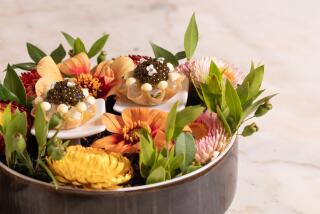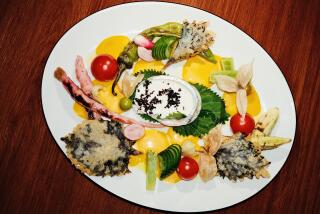Soup du Journey
GOLFE-JUAN, France — Fish stew for 80 bucks? Are you out of your mind?
That was my gauche reaction a decade ago to a suggestion by one of my French newspaper colleagues at the Cannes Film Festival that we splurge on a meal at an out-of-town restaurant famous for its bouillabaisse.
If you haven’t had bouillabaisse at Tetou, you haven’t been to the Riviera, she said.
I really haven’t been surprised at the cost of haute cuisine on the Cote d’Azur since my first trip to Cannes in 1983, when a movie producer told me about a $9,000 dinner he and 11 others had enjoyed earlier that week at the three-star Le Moulin de Mougins a few miles north of the city. But that was for a seven- or eight-course, studio-expensed meal that took several hours to consume and many bottles of vintage wine to wash down, in a restaurant that was taking reservations for the following year.
What I had been asked to consider was ordering fish stew at a beach-side bistro that would cost $80, plus cab fare, on an expense account that sets off alarms when the tab reaches $25.
My friend taunted me with descriptions of steaming fish broth ladled over toasted croutons slathered with rouille, and of the plates of fresh Mediterranean fish that would follow. Rouquier . . . chapon . . . St.-Pierre . . . she said, tasting each word before letting it go. And the dessert . . . beignets and fresh jams. . . .
It’s hard to say no when your mouth is watering--it’s hard to say anything--so off we went. On the cab ride to Tetou, I got the short course in the history of bouillabaisse, a dish unique to the span of coastal Provence that runs from Marseille to the Italian border. You’ll find bouillabaisse on menus all over the world, my friend said, but you’ll find bouillabaisse only here.
The real thing is made from fish exclusive to the Mediterranean. Bouillabaisse’s origin is a subject of great mythological speculation in France. One legend has it that the first dish was prepared in heaven and served to shipwrecked saints. Another ascribes its invention to a candlelight conspiracy on Mt. Olympus, where Venus used it to lull her husband, Vulcan, the god of fire, to sleep so she could fool around with Mars, the god of war. Talk about living dangerously.
Less romantic stories credit the first bouillabaisse recipe to the abbess of a Marseille convent, said to have created it while preparing menus for meatless Fridays, and to a Provencal widow, who cleaned the kitchen making a welcome-home stew for her son. A more likely story is that it was conceived over time by fishing families along the coast, simply making use of whatever was hauled up in the day’s catch.
In any event, bouillabaisse is deeply ingrained in Provencal culture, and in its tourism. Fish fanciers from everywhere make pilgrimages to southern France for the bouillabaisse. Purists here will direct them to the area from Marseille to Toulon, which is still steeped in its fishing traditions. But some people believe the finest bouillabaisse in all of France is to be had at Tetou in Golfe-Juan, on the two-lane road that runs west from Cannes to Cap d’Antibes.
Though it boasts a new facade, the family-owned restaurant has changed very little since my first visit, I found on this year’s return. Tetou has been here since 1920, except for the brief period during World War II when the area became a German fortified beach. It was rebuilt after the war; it burned down; it was rebuilt, always resting on pilings that carry it from the foot of Boulevard Freres-Roustan to the edge of the Mediterranean.
Arriving early is rewarded with a table along the bank of windows opening up to the sea. The blue sky is pulled into the restaurant by the blue-and-white decor, synchronizing the appetite with the environment. It’s a warm Sunday afternoon, and Dominique Gay is our waitress. “Bouillabaisse?” she queries. You bet!
Pierre-Jacques Marquis, one of Tetou’s fourth-generation owners, says bouillabaisse accounts for 60% to 70% of the restaurant’s business, and the percentage goes up during the Cannes festival, when one of the world’s richest industries is in the area and just dying for an exotic meal. So are a pair of working journalists, on the last day of the film festival.
First up, the broth. Dominique delivers two large bowls, a plate of freshly toasted whole-wheat baguette rounds and a dish of rouille, a garlicky paste with cayenne, herbs and mayonnaise. You spread generous amounts of rouille over the croutons and lay them in the bowl, after which Dominique drenches them with hot fish soup. The soup can be a meal in itself, and lesser variations often appear as entrees at restaurants on the Riviera.
*
But we’ve only just begun. Here’s Dominique again, holding a platter of cooked whole fish. Marquis says Tetou uses only fish that are caught by hook. Netting damages the skin and bruises the flesh, he says. The fish are caught as far away as the coast of Tunisia and Morocco, and as close as the eye can see.
The day’s catch dictates the day’s bouillabaisse recipe, and among today’s catch are loup, galinette, St.-Pierre, baby crabs and the fiercely ugly chapon, a spiny red fish with a uniquely delicate flavor. Bouillabaisse can be made from many different Mediterranean species, but chapon, better known in the Marseilles region as rascasse, is essential.
Dominique displays the first platter of fish, a little taste for the eye, then bones them at the table. Along with this come baby crabs, potatoes, more bread, more rouille, more broth. Dominique’s next trip from the kitchen brings a second platter with three more whole fish, which she again bones at the table.
Her last trip delivers the coup de gra^ce: fresh-from-the-fryer beignets (French fritters laced with juice pressed from orange flowers in nearby Vallauris) plus six Technicolor jars of homemade jams--peach, fig, orange and cherry among them. You spread the jam over the beignets and blast off on the ultimate sugar high. You swear you’ll try just a little taste of each, and 4,000 calories later you’ve tried them all. (The safest time to go to Tetou is in the summer, when the weather is too warm for the preservative-free beignets and you can settle for Tetou’s fabulous sorbet made from black currants.)
The tab for this year’s bouillabaisse meal, which included salad, coffee, dessert, mineral water and a bottle of fragrantly fresh Lucien Crochet Sancerre, came to 1,450 francs, about $120 each. A lot for fish stew, yes, but a bargain for what may be the best bouillabaisse on the Riviera.
*
Mathews is film critic for Newsday, the Long Island, N.Y., newspaper.
(BEGIN TEXT OF INFOBOX / INFOGRAPHIC)
GUIDEBOOK
Go Fish
Where to eat: Tetou, in the beach town of Golfe-Juan, is about a 15-minute cab ride east of Cannes; telephone 011-33-4-9363-7116; fax 011-33-4-9363-1677. Open daily except Wednesday; closed Oct. 30 to Dec. 20, and in March.
More to Read
Sign up for The Wild
We’ll help you find the best places to hike, bike and run, as well as the perfect silent spots for meditation and yoga.
You may occasionally receive promotional content from the Los Angeles Times.






